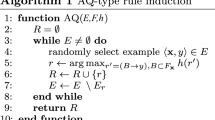Abstract
In this paper, we propose a new method for measuring the closeness of multiple sets of rules that are combined using Dempster’s rule of combination to improve classification performance. The closeness provides an insight into combining multiple sets of rules in classification − in what circumambience the performance of combinations of some sets of rules using Dempster’s rule is better than that of others. Experiments have been carried out over the 20-newsgroups benchmark data collection, and the empirical results show that when the closeness between two sets of rules is higher than that of others, the performance of its combination using Dempster’s rule is better than the others.
Access this chapter
Tax calculation will be finalised at checkout
Purchases are for personal use only
Preview
Unable to display preview. Download preview PDF.
Similar content being viewed by others
References
Freund, Y., Schapire, R.: Experiments with a new boosting algorithm. In: Proc of the Thirteenth International Conference on Machine Learning, pp. 148–156 (1996)
Cohen, W.W., Singer, Y.: Simple, Fast, and Effective Rule Learner. In: Proc of Annual Conference of American Association for Artificial Intelligence, pp. 335–342 (1999b)
Weiss, S.M., Indurkhya, N.: Lightweight Rule Induction. In: Proc of the International Conference on Machine Learning (2000)
Xu, L., Krzyzak, A., Suen, C.Y.: Several Methods for Combining Multiple Classifiers and Their Applications in Handwritten Character Recognition. IEEE Trans. on System, Man and Cybernetics 22(3), 418–435 (1992)
Whiteaker, C.J., Kuncheva, L.: Examining the Relationship between Majority Vote Accuracy and Diversity in Bagging and Boosting. Technical report. University of Wales, Bangor (2003)
Kittler, J., Hatef, M., Duin, R.P.W., Matas, J.: On Combining Classifiers. IEEE Transactions on pattern Analysis and Machine Intelligence 20(3), 226–239 (1998)
Cho, S.B., Kim, J.H.: Combining Multiple Neural Networks by Fuzzy Integral for Robust Classification. IEEE Trans. Systems, Man, and Cybernetics 25(2), 380–384 (1995)
Shafer, G.: A Mathematical Theory of Evidence. Princeton University Press, Princeton, New Jersey (1976)
Guang, J.W., Bell, D.A.: Rough computational methods for information systems. Artificial Intelligence 105, 77–103 (1998)
Bi, Y.: Combining Multiple Classifiers For Text Categorization Using The Dempster-Shafer Theory Of Evidence, PhD thesis, University of Ulster (2004)
Author information
Authors and Affiliations
Editor information
Editors and Affiliations
Rights and permissions
Copyright information
© 2006 Springer-Verlag Berlin Heidelberg
About this paper
Cite this paper
Bi, Y., Wu, S., Huang, X., Guo, G. (2006). Combining Multiple Sets of Rules for Improving Classification Via Measuring Their Closenesses. In: Yang, Q., Webb, G. (eds) PRICAI 2006: Trends in Artificial Intelligence. PRICAI 2006. Lecture Notes in Computer Science(), vol 4099. Springer, Berlin, Heidelberg. https://doi.org/10.1007/978-3-540-36668-3_135
Download citation
DOI: https://doi.org/10.1007/978-3-540-36668-3_135
Publisher Name: Springer, Berlin, Heidelberg
Print ISBN: 978-3-540-36667-6
Online ISBN: 978-3-540-36668-3
eBook Packages: Computer ScienceComputer Science (R0)




